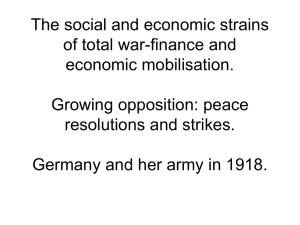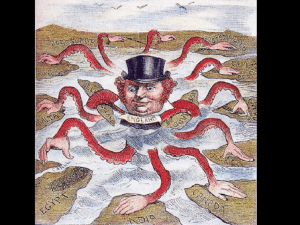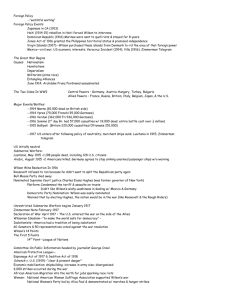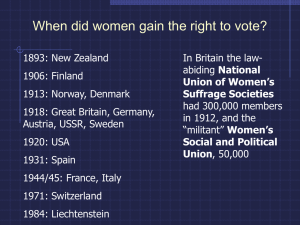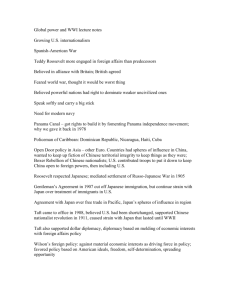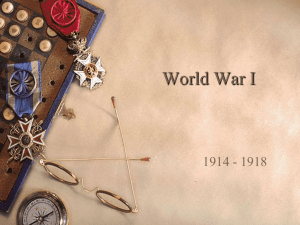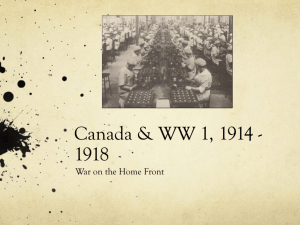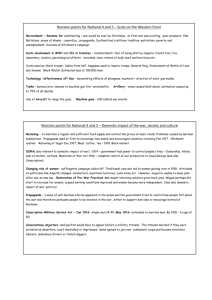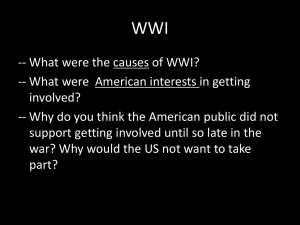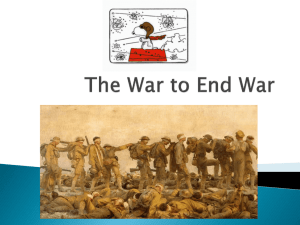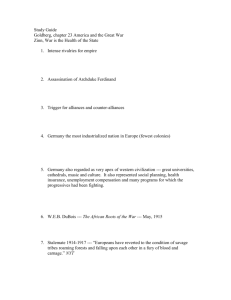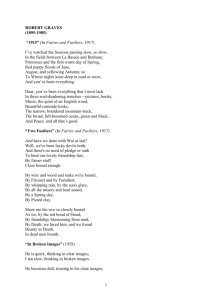PowerPoint Presentation - The Great War: World War I The War to
advertisement
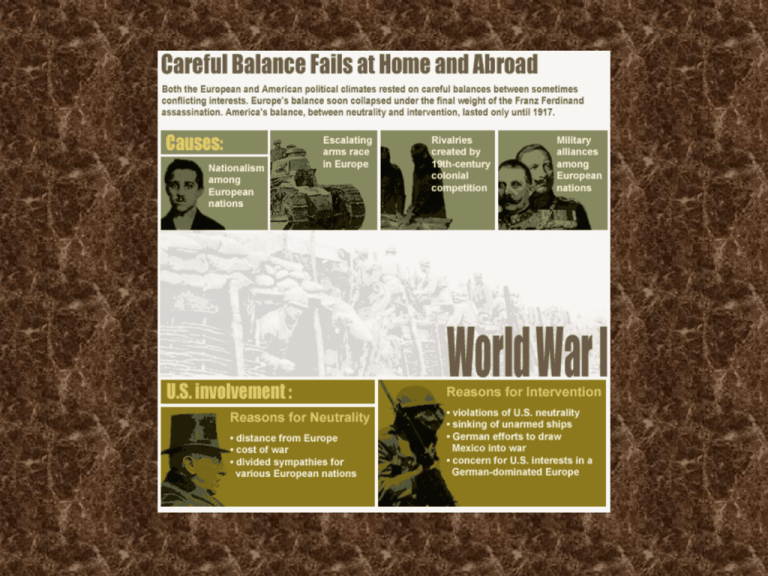
The Great War: World War I The War to End All Wars “The lamps have gone out all over Europe and we shall not see them lit again in our lifetime.” - British Prime Minister Lord Grey Long Term Causes of World War I • • • • • Nationalism Militarism Imperialism Peace time alliances Long-standing ethnic grudges Map 22.1 European Alliances in 1914 (p. 638) 25_8.jpg Short term timeline leading to World War I • June 28 - Assassination of Austro-Hungarian Archduke and heir, Francis Ferdinand (and Sophie, his wife) • July 23 - Austria issues ultimatum to Serbia and invades on July 27 • July 28-30 - Russians mobilize as Serbia’s ally • August 1 - Germany, Austria-Hungary’s ally, declares war on Russia (and Serbia) • August 3 - Germany declares war on France (allied with Russia) and invades Belgium en route to Paris, France • August 4 - Great Britain, France’s ally, declares war on Germany The sides formed • Triple Entente (Allies) – – – – – France Great Britain Italy Russia (1917 exit) United States (1917 entry) • Central Powers – Germany – Austria-Hungary (empire) – Ottoman Empire – Bulgaria United States remains neutral • Woodrow Wilson: “Remain neutral in thought as well as deed” • To protect international trading rights • “He kept us out of war.” 1916 presidential campaign slogan U.S. Neutrality under fire • British blockade of North Sea • Germans engage in submarine (u-boat) warfare • Lusitania crisis (May 1915) British liner sunk by German U-boats • Arabic and Sussex sinkings (Germans issue Sussex pledge) • Economic ties with Britain and France - war time trade and US financing of allied war effort Shifting US public opinion • Reports of German cruelty (Huns) reinforced by Lusitania • Ethnic loyalties • Native born Americans (not Indians) favored Britain and French victory • British War Propaganda • Pro-War politicians (TR) More Propaganda Preparedness • Greater $ for military spending necessary • National Security League • National Defense Act: June 1916 • Midwest and Western Americans opposed to preparedness (Populists, Progressives, Socialists) Election of 1916 • • • • “He Kept us out of War” Peace efforts had failed Wilson narrowly won January 1917, “Peace without Victory” Speech • April 1917, Wilson asked for declaration of war. From Neutrality to War • Zimmermann Telegram (1917) • Russian Revolution (1917) • Unrestricted Submarine Warfare • “The World Must be made safe for Democracy” (Progressive crusade) Mobilization in the USA • War Industries Board (Bernard Baruch) coordinated production and price controls • Food Administration (Herbert Hoover) voluntary efforts to conserve food for soldiers • Financing - Liberty Bonds 25_10.jpg America and the War Effort (p. 636) “Remember Your First Thrill of American Liberty” (p. 649) Wartime Public Opinion • Committee on Public Information propaganda agency in America (George Creel) “do your bit” for the war • Hate the Hun, Liberty Cabbage, Salisbury Steak, Can the Kaiser Wartime Civil Liberties • Espionage and Sedition Acts (1917-18) jail sentences for those critical of disloyal or abusive remarks toward US war effort • Schenck v. United States (1919) “clear and present danger” - free speech could be limited The Armed Forces • Selective Service Act (1917) draft: 2.8 million draftees, 2.9 million volunteers • Eventually 2 million were sent to Europe • Blacks - 400,000 served, few officers • Blacks hoped for service abroad = equal rights at home (not so) American Society • Women took mens jobs while men were “Over There” led to Nineteenth Amendment • Mexicans - left Mexico (upheaval and revolution) and took jobs in American West • Blacks - Great Migration to northern cities for job opportunities and to escape poverty Fighting the War • New style of warfare: mechanized – Machine guns – tanks – long-range, heavy artillery – poison gas (various types) – Trench warfare (not entirely new) – “No-Man’s Land” – Hand grenades Other factors after US entry • Russian revolution and withdrawal (Treaty of Brest-Litovsk) allowed Germany to focus on Western front entirely • Naval shipping losses = huge. Led to “Convoy System” and record ship construction Pershing’s Crusaders: The Doughboys • American Expedition ary Force (AEF) • General John J. Pershing • First major action in spring 1918 American Battles:1918 • German Counteroffensive • Chateau-Thierry (2nd Battle of the Marne) • Belleau Wood (June 1918) • Meuse (river) Argonnes (forest) Offensive (Fall 1918) • St. Mihiel • November 11, 1918 Armistice (cease-fire) 25_13.jpg American Troops at the Western Front, 1918 Map 22.2 U.S Participation on the Western Front, 1918 (p. 644) 25_19.jpg 25_16.jpg Casualties • 50,000 Americans died in 1918 combat • 1918 Influenza epidemic (worldwide) killed thousands of soldiers and millions of people around the globe • 112,000 American fatalities Approximate Comparative Losses in World War I Winning the Peace: The Versailles Peace Conference • Paris and Palace of Versailles • Big Four: – Woodrow Wilson (USA) – David Lloyd George (GBR) – Georges Clemenceau (FR) – Orlando Vittorio (IT) • Russia excluded • Defeated powers humiliated • Wilson’s 14 points the major proposal Wilson’s 14 Points • To “make the world safe for democracy” • #1-5 - international law recommendations • #6-13 - European boundary restructure • #14 - League of Nations page1012.jpg page1039.jpg Map 22.3 The Great Migration and Beyond (p. 650)
